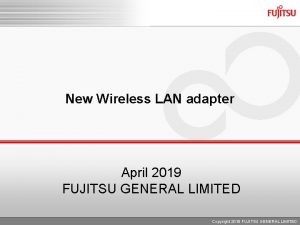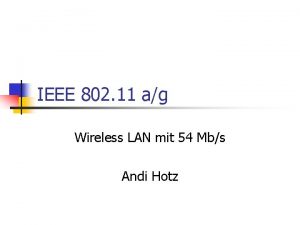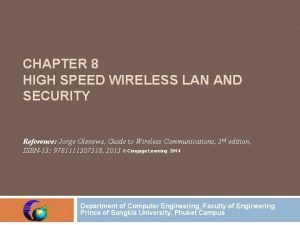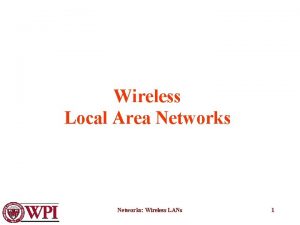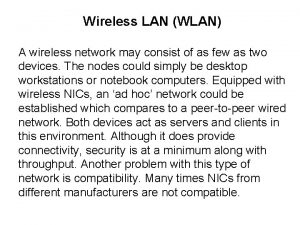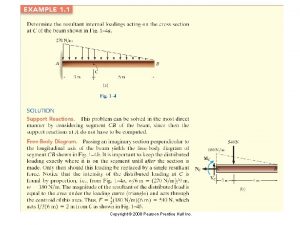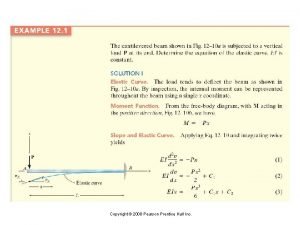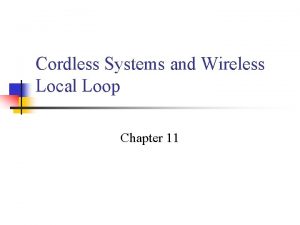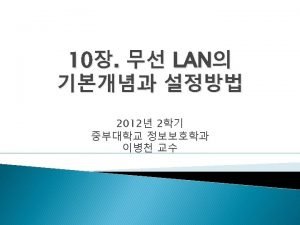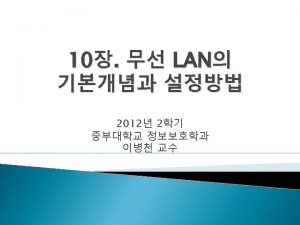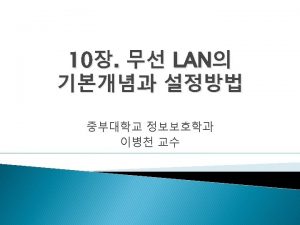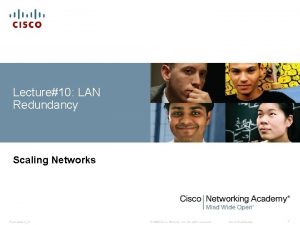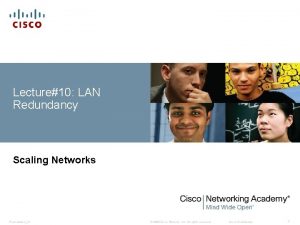Wireless LAN Operations PresentationID 2008 Cisco Systems Inc


























- Slides: 26

Wireless LAN Operations Presentation_ID © 2008 Cisco Systems, Inc. All rights reserved. Cisco Confidential 1

Wireless LAN Operations 1. Wireless 802. 11 Frame 2. Wireless LAN Operations • CSMA/CA • Wireless Clients and Access Point Association • Association Parameters • Discovering Aps • Authentication 3. Channel Management • Frequency Channel Saturation • Selecting Channels 4. Planning WLAN Deployment 5. Summary Presentation_ID © 2008 Cisco Systems, Inc. All rights reserved. Cisco Confidential 2

Objectives § Describe wireless Frame types. § Describe the content method used in a wireless environment. § Describe association process. § Describe channel management § Describe WLAN deployment plan Presentation_ID © 2008 Cisco Systems, Inc. All rights reserved. Cisco Confidential 3

802. 11 Frame Structure Wireless 802. 11 Frame Presentation_ID © 2008 Cisco Systems, Inc. All rights reserved. Cisco Confidential 4

802. 11 Frame Structure Wireless Frame Type Presentation_ID © 2008 Cisco Systems, Inc. All rights reserved. Cisco Confidential 5

802. 11 Frame Structure Management Frames Presentation_ID © 2008 Cisco Systems, Inc. All rights reserved. Cisco Confidential 6

802. 11 Frame Structure Control Frames Presentation_ID © 2008 Cisco Systems, Inc. All rights reserved. Cisco Confidential 7

Wireless Operation CSMA/CA Flowchart Presentation_ID © 2008 Cisco Systems, Inc. All rights reserved. Cisco Confidential 8

Wireless Operation Wireless Clients and Access Point Association Figure 1 Presentation_ID © 2008 Cisco Systems, Inc. All rights reserved. Cisco Confidential 9

Wireless Operation Association Parameters § SSID – Unique identifier that wireless clients use to distinguish between multiple wireless networks in the same vicinity. § Password – Required from the wireless client to authenticate to the AP. Sometimes called the security key. § Network mode – Refers to the 802. 11 a/b/g/n/ac/ad WLAN standards. APs and wireless routers can operate in a mixed mode; i. e. , it can simultaneously use multiple standards. § Security mode – Refers to the security parameter settings, such as WEP, WPA, or WPA 2. § Channel settings – Refers to the frequency bands used to transmit wireless data. Wireless routers and AP can choose the channel setting or it can be manually set. Presentation_ID © 2008 Cisco Systems, Inc. All rights reserved. Cisco Confidential 10

Wireless Operation Discovering APs Passive mode § AP advertises its service by sending broadcast beacon frames containing the SSID, supported standards, and security settings. § The beacon’s primary purpose is to allow wireless clients to learn which networks and APs are available in a given area. Active mode § Wireless clients must know the name of the SSID. § Wireless client initiates the process by broadcasting a probe request frame on multiple channels. § Probe request includes the SSID name and standards supported. § May be required if an AP or wireless router is configured to not broadcast beacon frames. Presentation_ID © 2008 Cisco Systems, Inc. All rights reserved. Cisco Confidential 11

Wireless Operation Discovering APs Figure 1 Presentation_ID © 2008 Cisco Systems, Inc. All rights reserved. Cisco Confidential 12

Wireless Operation Discovering APs Figure 2 Presentation_ID © 2008 Cisco Systems, Inc. All rights reserved. Cisco Confidential 13

Wireless Operation Authentication § Open authentication – A NULL authentication where the wireless client says “authenticate me” and the AP responds with “yes. ” Used where security is of no concern. § Shared key authentication – Technique is based on a key that is pre-shared between the client and the AP. Presentation_ID © 2008 Cisco Systems, Inc. All rights reserved. Cisco Confidential 14

Channel Management Frequency Channel Saturation Direct-sequence spread spectrum (DSSS) § Uses spread-spectrum modulation technique; designed to spread a signal over a larger frequency band making it more resistant to interference. § Used by 802. 11 b. Frequency-hopping spread spectrum (FHSS) § Relies on spread-spectrum methods to communicate. § Transmits radio signals by rapidly switching a carrier signal among many frequency channels. § This channel-hopping process allows for a more efficient usage of the channels, decreasing channel congestion. § Used by the original 802. 11 standard. Presentation_ID © 2008 Cisco Systems, Inc. All rights reserved. Cisco Confidential 15

Channel Management Frequency Channel Saturation (cont. ) Orthogonal Frequency-Division Multiplexing (OFDM) § Subset of frequency division multiplexing in which a single channel utilizes multiple subchannels on adjacent frequencies. § Because OFDM uses subchannels, channel usage is very efficient. § Used by a number of communication systems, including 802. 11 a/g/n/ac. Presentation_ID © 2008 Cisco Systems, Inc. All rights reserved. Cisco Confidential 16

Presentation_ID © 2008 Cisco Systems, Inc. All rights reserved. Cisco Confidential 17

Presentation_ID © 2008 Cisco Systems, Inc. All rights reserved. Cisco Confidential 18

Presentation_ID © 2008 Cisco Systems, Inc. All rights reserved. Cisco Confidential 19

Channel Management Selecting Channels Figure 1 highlights which 802. 11 standard operates in the 2. 4 GHz, 5 GHz, and 60 GHz bands. Each spectrum is subdivided into channels with a center frequency and bandwidth, analogous to the way radio bands are subdivided. Presentation_ID Figure 1 © 2008 Cisco Systems, Inc. All rights reserved. Cisco Confidential 20

Channel Management Selecting Channels (cont. ) The solution to 802. 11 b interference is to use nonoverlapping channels 1, 6, and 11. Presentation_ID © 2008 Cisco Systems, Inc. All rights reserved. Cisco Confidential 21

Channel Management Selecting Channels (cont. ) Use channels in the larger, less-crowded 5 GHz band, reducing “accidental denial of service (Do. S), ” this band can support four non-overlapping channels. Presentation_ID © 2008 Cisco Systems, Inc. All rights reserved. Cisco Confidential 22

Channel Management Selecting Channels (cont. ) Channel bonding combines two 20 -MHz channels into one 40 -MHz channel. Presentation_ID © 2008 Cisco Systems, Inc. All rights reserved. Cisco Confidential 23

Channel Management Planning a WLAN Deployment § If APs are to use existing wiring, or if there are locations where APs cannot be placed, note these locations on the map. § Position APs above obstructions. § Position APs vertically near the ceiling in the center of each coverage area, if possible. Figure 1 Presentation_ID § Position APs in locations where users are expected to be. © 2008 Cisco Systems, Inc. All rights reserved. Cisco Confidential 24

Summary § An STA first authenticates with an AP, and then associates with that AP. § The 802. 11 i/WPA 2 authentication standard should be used. Use the AES encryption method with WPA 2. § When planning a wireless network, nonoverlapping channels should be used when deploying multiple APs to cover a particular area. There should be a 10– 15 percent overlap between BSAs in an ESS. § Cisco APs support Po. E to simplify installation. Presentation_ID © 2008 Cisco Systems, Inc. All rights reserved. Cisco Confidential 25

Presentation_ID © 2008 Cisco Systems, Inc. All rights reserved. Cisco Confidential 26
 2008 2008
2008 2008 What are wireless devices and the wireless revolution
What are wireless devices and the wireless revolution Fujitsu air conditioner wifi adapter
Fujitsu air conditioner wifi adapter Juniper wlm series wireless lan managers
Juniper wlm series wireless lan managers Juniper wlm series wireless lan managers
Juniper wlm series wireless lan managers Wireless lan 802
Wireless lan 802 High speed wireless lan
High speed wireless lan Wireless lan protocols
Wireless lan protocols Wireless lan protocols
Wireless lan protocols What does a wireless lan (wlan) act as to a wired network?
What does a wireless lan (wlan) act as to a wired network? Wireless lan applications
Wireless lan applications Lan switching and wireless
Lan switching and wireless 2008 pearson prentice hall inc
2008 pearson prentice hall inc 2008 pearson prentice hall inc
2008 pearson prentice hall inc 2008 pearson prentice hall inc
2008 pearson prentice hall inc Pearson
Pearson 2008 pearson education inc
2008 pearson education inc Copyright 2003 pearson education inc
Copyright 2003 pearson education inc 2008 pearson education inc
2008 pearson education inc 2008 pearson education inc
2008 pearson education inc Pearson
Pearson 2008 pearson education inc
2008 pearson education inc Layers and components of the artery wall
Layers and components of the artery wall Sensor wireless inc
Sensor wireless inc Ul 1069 wireless nurse call systems
Ul 1069 wireless nurse call systems Dect protocol architecture
Dect protocol architecture International operations management
International operations management


